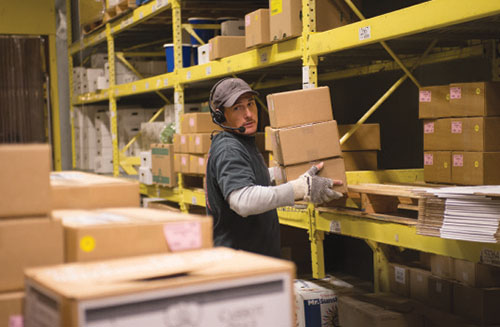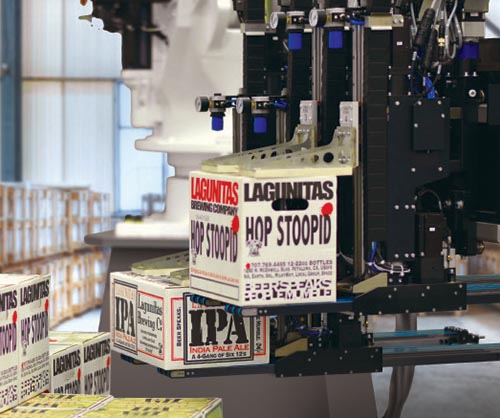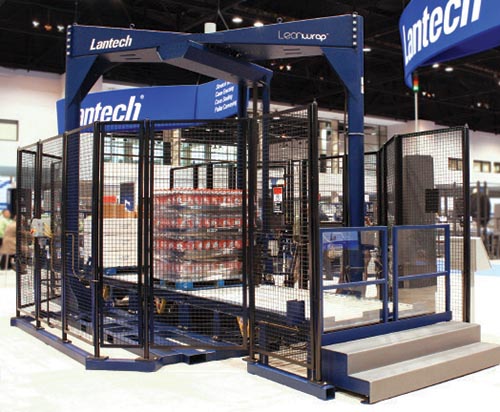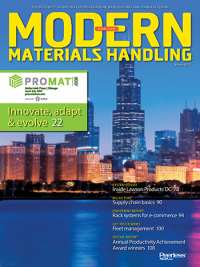From Raw to Retailer: 4 technology trends in food and beverage market
Emerging trends in products and packaging are sprouting innovative picking and packaging technologies for the food and beverage market.
Farm-to-fork traceability regulations. Consumer safety. Product and packaging type proliferation. Thinner packaging to meet sustainability initiatives. More complicated pallet-building requests. It’s a veritable smorgasbord of challenges when it comes to handling today’s food and beverage products.
From raw ingredients to retailer, food and beverage handlers are relying on the latest technologies to get products safely to the store shelves—and back in the case of a recall. Among them, there are picking and data capture systems, smart pallets, robotic palletizers, and intelligent stretch wrappers.
Here, Modern looks at four materials handling picking and packaging technologies that are making mincemeat out of the food and beverage market’s challenges.

1.) Mobile work execution systems merge optimization with voice- and scan-based picking systems.
For consumer safety, food and beverage product track-and-trace data capture compliance continues to be a big issue within the industry, says Ron Kubera, executive vice president and chief marketing officer at Lucas Systems.
“At every level of the supply chain, our customers are heavily affected by the need to know which of their customers are getting which products in case there is a recall,” Kubera explains. “That creates new pressures on them to capture lot numbers or other information as they’re picking items.”
However, adding yet another step to a manual picking process slows down throughput and increases labor costs. For that reason, Lucas Systems is providing a mobile work execution system that merges optimization software and multiple picking technologies into a single solution.
Packaged together are mobile devices, usually a smart phone or tablet, headsets that allow the use of voice direction and speech recognition to help a picker locate an item and confirm its pick quantity, along with a bar code scanner. The scanner captures dates, batch and lot numbers, catch weights and other data that would be cumbersome to speak, write or key into a device.
“Further, when you think about someone picking in a cooler or freezer environment, where an associate is wearing gloves, a system like this makes the picking process faster, easier and more accurate,” Kubera continues.
Additionally, when all pickers are equipped with such a system, the overarching control software can be used to maximize efficiency and productivity when creating and doling out pick assignments.
“We’re using multi-variable algorithms that allow us to dynamically optimize a mobile worker’s productivity and performance based on the current warehouse layout, constraints within the operation, and the flow of product throughout a facility,” he adds. “By using algorithms to calculate the most optimal pick path—or redirect a worker away from a congested aisle in real time—the software dramatically reduces the amount of travel and time people spend when picking.”
2.) Smart pallets enable track-and-trace with the Internet of Things.
When considering ways to better ensure food and beverage safety, companies handling both ingredients and products continue to evaluate and adopt non-wood pallets, including those made of plastic or composite materials.
“Not only do wood pallets harbor many potential contaminants—insects, mold, mildew, bacteria, broken pieces of wood and rusty nails—their inconsistency in size and weight can be problematic for users of automated machinery or robotics that require tight tolerances,” says Dave Kalan, senior vice president of marketing and business development at RM2.
The cost of non-wood pallets, however, can be challenging, which is why manufacturers like RM2 and others offer a rental model. That said, tracking and tracing the pallets has been limited to radio frequency identification (RFID) tags embedded in every pallet or global positioning system (GPS) devices on the payload. “Both systems are expensive and, in the case of RFID, require additional infrastructure to use,” he says.
Instead, RM2 turned to a service being rolled out by AT&T called LTE-M—engineered to support Internet of Things (IoT) machine-to-machine (M2M) communication—that leverages existing cell towers. “We’re embedding a device called RM2ELIoT, which stands for ‘Electronic Link to the Internet of Things,’ in the center block of our composite pallets to protect it from forklift impacts and water intrusion during any pallet wash and sanitization process,” Kalan explains, noting that it includes an RFID tag as well. “RM2ELIoT communicates via LTE-M to give us all kinds of pallet-related data.”

The data not only helps RM2 locate their pallets to keep them within the rental program, but also supports track-and-trace activities for the food and beverage products stored and transported on them, he says. “The system will provide location and time data that can be tied into existing inventory data.”
The pallets themselves will be much easier to locate quickly in the event of a recall. Because all gathered information is Cloud-based, customers can access it either using a user-specific online portal and application program interface (API), or opt to receive regular reporting from RM2.
3.) Robotic palletizing’s flexibility accommodates proliferation of SKUs, variable customer load requirements.
In food and beverage distribution, the twin challenges of an extreme proliferation of stock keeping units (SKUs) and a broad spectrum of customer load-building requirements collide at the palletizer. To maintain maximum flexibility in building a palletload of products, most facilities rely on robotics.
“In food and beverage, packages are generally getting more difficult to handle because they come in a much wider variety of sizes and shapes. Consider that beer now comes in 18-packs, fridge packs, cubes, 24-packs, party packs, 30-packs, bottles and cans,” says Doug Stoll, palletizing product manager at Intelligrated. That means a single palletizer at a producer or distributor might handle 20 different types of packaging for a single brand of beer.
Although robotic palletizers generally don’t match conventional machinery in terms of throughput rates, their ability to handle a variety of product types and sizes make them a more common choice for food and beverage. They can be equipped with different end-of-arm tooling devices, sometimes more than one at a time, to handle different product types simultaneously, like bagged or boxed flour, Stoll says.
Other challenges include the trend of shipping products direct from the manufacturer to the retail store. Instead of handling corrugated cases, product packaging is exposed to the consumer as it sits on the pallet.
“Someone shipping a pallet of product to a membership-only warehouse club retailer, for example, has full-color printed graphics that need to be handled gently so they aren’t damaged, and turned so they face the aisle on all four sides of the pallet,” Stoll explains. “Those packages have a different coefficient of friction and can be easily damaged; they’re also getting smaller, lighter, taller, narrower and have thinner sidewalls—like water bottles.”
To ensure gentle product handling when building a pallet load, Intelligrated has been deploying servo drives and motors particularly in machines destined for food and beverage applications.
“It’s a more expensive technology, but it supports quick changeovers from one product to another for minimal downtime,” adds Stoll. “Servos also let us customize the operating parameters based on each SKU for better handling precision and finely tuned control of different functions, such as pushing or compacting a layer, accelerating or decelerating placement, and integrating sheet dispensers or corner boards for load stability.”
4.) Intelligent stretch wrappers protect multiple types of loads by applying proper containment force.
Loads palletized specifically to be display-ready must stay that way during storage and transit. That’s where effective unitizing using stretch wrapping comes into play.

“Our latest technologies are engineered to help users make sure our customer’s products aren’t damaged in transit and that they look good for the consumer when they get to the retail shelf,” explains Allison Myers, senior marketing product manager at Lantech. “At the same time, we’re seeing thinner product packaging—due to sustainability and cost cutting initiatives—and those items are more difficult to protect and ship.”
Proper application of containment force is the key element in maintaining and protecting product integrity during shipping and handling, she says. “Containment force is made up of film layers and film tension. Yet most users, particularly those handling the diverse and variable food and beverage products, don’t know how to adjust the various settings to make sure they’re wrapping their loads properly, so they arrive successfully,” Myers says.
To simplify the process, Lantech has added new technology to its L-series stretch wrappers that automatically calculates proper containment force based on a half dozen input queries filled in by a user at the machine’s touchscreen.
Based on information such as load height, weight, inherent stability and other factors, the machine’s software determines the appropriate settings for application factors like film tension, the number of film layers at the top, middle, and bottom of the load, and application speed.
“The system also allows for pre-programming of separate wrap profiles for every type of load,” continues Myers. “That allows users to accommodate the variable containment force characteristics of different products.”
Companies mentioned in this article:
Intelligrated
Lantech
Lucas Systems
RM2

Article Topics
Packaging News & Resources
Registration open for Pack Expo International 2024 Pack Expo East has largest show to date Optimize Parcel Packing to Reduce Costs CMC Packaging Automation North America unveils Tech Center in Atlanta PACK EXPO East brings latest packaging technologies to Philadelphia Loftware’s cloud-based labeling solutions take center stage Flexcon unveils its innovative bin solutions More PackagingLatest in Materials Handling
Registration open for Pack Expo International 2024 Walmart chooses Swisslog AS/RS and software for third milk processing facility NetLogistik partners with Vuzix subsidiary Moviynt to offer mobility solutions for warehouses Materials Handling Robotics: The new world of heterogeneous robotic integration BSLBATT is looking for new distributors and resellers worldwide Lucas Watson appointed CSO for Körber’s Parcel Logistics business in North America Hyster recognizes Dealers of Distinction for 2023 More Materials HandlingAbout the Author
Subscribe to Materials Handling Magazine

Find out what the world's most innovative companies are doing to improve productivity in their plants and distribution centers.
Start your FREE subscription today.
April 2024 Modern Materials Handling

Latest Resources












